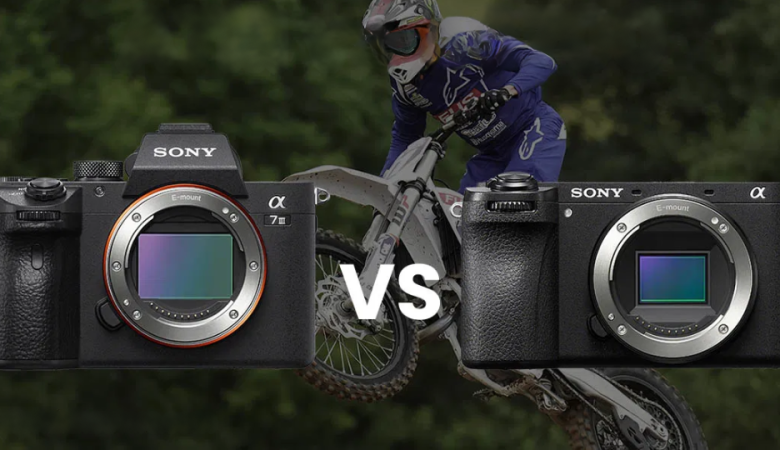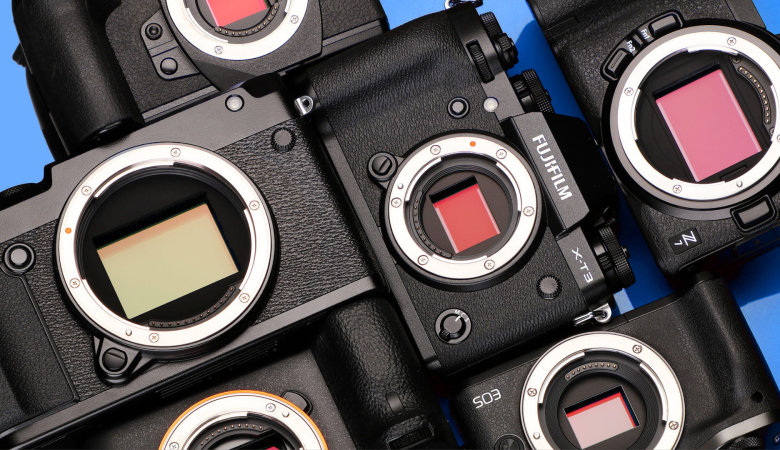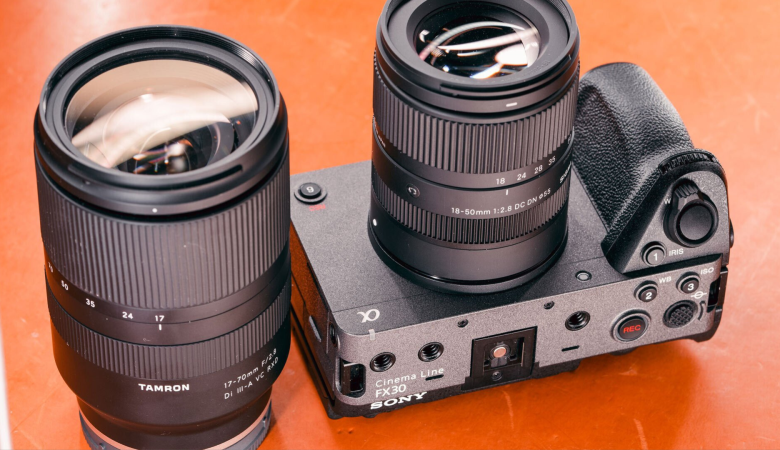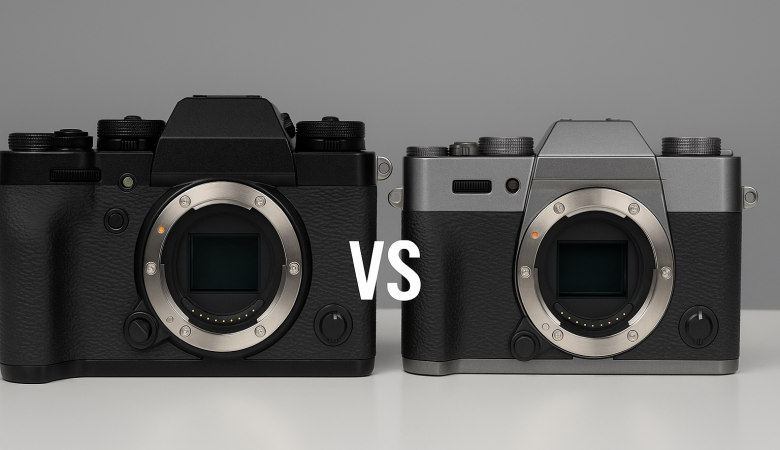Digital SLR cameras have really come a long way in around the past decade or so. Nowadays, even the entry-level DSLR cameras are quite advanced. And they are able to capture results that aren’t much inferior to their costlier and more high-end counterparts. And if you are a beginner, starting off with a cheaper DSLR is not a bad option. The Nikon D3500 and the Canon EOS Rebel T6 are two of the major contenders for the best entry-level DSLR camera crown. Therefore in today’s article, we are going to go over what features each has to offer and which one is worth your money. So let us begin.
In a Hurry? Here are Our Top Choices:
Here is a quick snapshot of our top-rated picks.
[amazon box=”B08KSLW8N3,B08KYGM5K5,B08KSMKHF3″ grid=”3″]Nikon D3500
Nikon is a pretty well-regarded manufacturer in the professional camera community. Launched back in August of 2018, their D3500 backs that trust up incredibly. For the price, it packs many features that are rare if not outright unavailable on other cameras at this range. The single-lens kit comes with an AF-P DX NIKKOR 18-55mm f/3.5 aperture lens. It’s decent for most beginners. But the two lenses kit it comes in even includes an expensive AF-P DX NIKKOR 70-300mm f/4.5 aperture ED lens. This is a fantastic value add on on top of an already spectacular camera which places it higher than its competition.
Body
Being an insanely feature-rich camera, you’d expect the D3500 to be big and bulky. However, surprisingly, it is actually somewhat smaller than other cameras at this price. Its actual dimensions are 4.88 x 2.76 x 3.82 inches without the lenses. Even with the included lenses or the ones you buy separately, the measurements should increase like most DSLRs. It has a standard Nikon F bayonet lens mount. Coming in at around 365 g (just for the body), it is actually notably lighter than other cameras too. The body doesn’t come with any form of weather sealing at all. But that is to be expected as no camera at this price does.
[amazon box=”B07GWKDLGT” button_text=”Check it now on Amazon”]Battery Life
The D3500 launched recently. So it is much more efficient than older cameras. The camera uses a rechargeable EN-EL14a Lithium-ion power pack. It takes 1550 images before chewing through its battery completely, which is very impressive for a DSLR at this range. The camera even comes with an MH-24 quick charger that charges the battery very fast. However, no matter how impressive a camera battery is, we always recommend you to keep a charged backup battery ready.
Sensor
This camera comes with a large APS-C CMOS sensor. In fact, it has the largest sensor at this price bracket. The sensor is 23.5mm wide, 15.6mm high, and 28.2mm from corner to corner. So the sensor area is 366.6 millimeters squared, which is pretty massive. The best format factor for this camera is 1.5, which is really good. But even with such a large sensor, the camera weighs lower than other smaller sensor cameras, as mentioned before. At 24.2MP, the resolution of the D3500 is relatively high as well. The max image resolution you can get with this camera is 6000 x 4000 pixels.
The sensor doesn’t have an OLPF (Optical Low Pass Filter/anti-alias filter). That means you should get sharper images. The pixel pitch of this sensor is 3.91 μm, which is smaller than most. So the pixel density also shoots to an impressive 6.55 MP per square centimeter. The sensor supports a native ISO range from 100 to 25,600. However, we would say that it is usable, going up to 6400 at the right time with the correct settings. It gets way too grainy and noisy after that. It doesn’t have any ISO boosting option. The native aspect ratio of this sensor is 3:2 (ratio of sensor width and sensor height). All in all, it is an excellent image sensor.
Connectivity
The Nikon D3500 does have Bluetooth 4.1 support for easy transfer. And it supports the SnapBridge app. Although the camera does not have built-in WiFi, it is Eye-Fi compatible. So in case you are willing to work with Eye-Fi, you can have all the conveniences of using WiFi.
Features
This camera has a fast readout speed sensor that can shoot videos. It can shoot footage at up to 1080p resolution at 60 FPS. It has a 0.57x magnification optical viewfinder which again is higher than the rest of its competition. The viewfinder offers 95% FOV (Field Of View) as well. So images appear closer and more detailed than they actually are through the viewfinder. The Nikon D3500 supports SD, SDHC, and SDXC cards for storage, similar to other cameras. The most notable feature here is that it supports fast UHS-1 storage. It has a Type C mini-pin HDMI connector for connecting it to external displays.
Nikon also added 3d tracking autofocus feature to this camera. This feature could only be found on higher-end professional cameras before. But now you can even get it on an entry-level DSLR. It works pretty well and is very useful for capturing fast-moving objects (e.g., fast-paced sports). And the camera can shoot five frames per second. So you can basically hold down the shutter button and do what is known as “spray and pray” in ph otography terms. Later, you can scrub through the photos and select the best one for your needs. It has a pretty good 3-inch 921k dot resolution fixed LCD monitor. The only bummer is that it is not touch-input capable.
- The two lenses kit includes an expensive AF-P DX NIKKOR 70-300mm f/4.5 aperture ED lens.
- Small and compact body.
- Lightweight and easy to travel with.
- Great battery life.
- Quick charge support.
- Large sensor.
- SnapBridge app support.
- 1080p 60 FPS video support.
- UHS-1 storage support.
- 3d tracking autofocus capable.
- 5 frames per second capturing capability.
- The monitor does not have touch input support.
- Weather sealing unavailable.
- No Near Field Communication (NFC) support for easy transfer.
- No inbuilt WiFi for uploading images to the web.
Canon EOS Rebel T6 (1300D)
Canon is another excellent brand, trusted by many professional photographers. Released back in March of 2016 the T6 is still a pretty capable camera. And some of its aspects still hold up to this date. The single-lens kit comes with an 18-55mm EF-S mount lens. However, the special two-lens kit comes with a 75-300mm zoom lens as well. That is why it is the second contender for the best entry-level DSLR crown.
Body
The Canon T6 is a pretty big DSLR. Its actual dimensions are 5.1 x 3.1 x 4 inches without the lenses. Even with the included lenses or the ones you buy separately, the measurements should increase like most DSLRs. At 485 g, the body is pretty heavy too. Still, it feels surprisingly good to hold and feels premium. The body isn’t weather-sealed, so we don’t recommend taking it out in harsh conditions. It has a standard Canon EF lens mount and can also take EF-S lenses. But do note that this camera does not support EF-M lenses. The SD card flap is on the bottom of the camera. So you might face some trouble if you need to take it out while being mounted on a gimbal or a tripod.
[amazon box=”B01CO2JPYS” button_text=”Check it now on Amazon”]Battery Life
This camera uses an LP-E10 battery pack and can take up to 500 shots on a full charge. It is decent and falls in line with other beginner-level DSLRs in terms of battery life. We recommend keeping a charged backup ready, especially with this camera, because it runs out so quickly.
Sensor
The Canon T6 comes with an APS-C CMOS sensor. The sensor is 22.3mm wide, 14.9mm high, and 26.8mm from corner to corner. So the total sensor area is 332mm². Due to that, the format size of the camera is 1.6, and it is a 17.9MP sensor. The max image resolution you can get with this camera is 5184 x 3456 pixels.
This camera has a native aspect ratio of 3:2. It has an anti-alias filter, so that is a bit of a bummer. The native ISO range of this camera is from 100 to 12800. However, the sensor supports ISO boost, which can increase the ISO up from 100 to 25600 as well. But it already adds some noise from 6400. So we recommend you operate below that range. The sensor also can capture three frames per second. This sensor has a pixel pitch of 4.31 μm, resulting in a pixel density of 5.39 MP/cm².
Connectivity
The Canon T6 is pretty much the cream of the crop when it comes to connectivity features at this price. It has built-in WiFi in order to upload images seamlessly. It has built-in NFC as well to transfer photos with just a tap on supported devices. You can even use the Canon Camera Connect app to upload your images to social media using your smartphone easily.
Features
This camera can shoot videos up to 1080p at 30 FPS. It has a 0.50x magnification optical viewfinder, and it offers a FOV (Field Of View) of 95%. The camera supports SD, SDHC, and SDXC memory cards as storage. It has a Type C mini-pin HDMI connector for connecting it to external displays. The output resolution options it can support are as followed: 1080/60i, 1080/50i, 480/60p, and 576/50p. Using the camera connect app, you can even shoot photos remotely with just a tap of a button. It has a 3 inch 920k dot resolution monitor. It is a fixed display without any touch input support.
- Three frames per second capturing capability.
- Near Field Communication (NFC) support for seamless pairing.
- Inbuilt WiFi support for easy cloud backup.
- Feels premium in hands and has a good grip.
- Canon Camera Connect app support
- Pretty big, bulky, and heavy.
- No weather sealing.
- The sensor has an anti-alias filter.
- No 1080p 60 FPS video support.
- UHS-1 storage support unavailable.
- No 3d tracking autofocus or similar feature.
- The monitor does not have touch input support.
Comparison
The Nikon D3500 is a much newer camera than the Canon T6 (by two years and five months). So the Nikon counterpart definitely has benefits given by technological advances in this time. However, the Canon T6 is by no means a bad camera, either. Being an old model, you are much more likely to find it at your desired price.
Body Comparison
The Nikon D3500’s body is about 8% smaller than the Canon T6 across the board. So it is markedly more portable than the Canon T6. The Nikon D3500 also weighs approximately 25% less than the Canon T6. So the Nikon counterpart is much easier to carry around. Still, the Canon T6 feels more comfortable to hold as it comes with a better grip and more thought out button placements for seamless control. It feels more premium than the Nikon D3500 as well.
As both cameras use an APS-C sensor, both should increase similarly in size with included or aftermarket lenses. For the Canon T6, the SD card flap is on the bottom of the camera. So you might face some trouble if you need to change it out while being mounted on a gimble or a tripod. But the D3500 does not have any such problem as the SD card flap is located on the side.
Battery Life Comparison
The Nikon D3500 pretty much demolishes the Canon T6 in this department. Not only does the D3500 offer more than triple the battery life of the T6, but it also supports quick charge. Being a newer camera, it is much more efficient as well. So the Nikon D3500 is the clear winner here.
Sensor Comparison
Both cameras come with an APS-C CMOS sensor. But the D3500’s sensor area is about 11% bigger. Both sensors feature a native aspect ratio of 3:2. However, the format factor for the D3500 is 1.5, and T6 is 1.6 due to the size difference. The D3500 also has a resolution lead over the T6 (18 megapixels) as it features a 24 megapixels sensor.
The pixel pitch of D3500 (3.91 μm) is smaller than the T6’s sensor pitch (4.31 μm) as well. Lower pixel pitch results in higher pixel density, which in turn results in sharper images. That is why the D3500 has a pixel density of 6.5 megapixels per cubic centimeter when the T6 only has 5.39 megapixels per cubic centimeter. The D3500, unlike the T6, doesn’t come with an anti-alias filter. This results in all details captured by the sensor being stored. And you get sharper images. The Canon T6 features a native ISO range from 100 to 12800. And that can be extended to 100-25600 with ISO boost. The Nikon D3500’s sensor features that ISO range natively but doesn’t support ISO boost. So you get much more flexibility with the Nikon counterpart. Still, on both cameras, we recommend staying below 6400 ISO under any condition in order to avoid noise.
So in this category too, the Nikon D3500 is the clear winner. More than two years of technological advancements in camera sensor technology is nothing to scoff at. And the Nikon D3500 proves that as it shines through and beats the T6 in every aspect in this category.
Connectivity Comparison
The Nikon D3500 only features Bluetooth 4.1 as its main connectivity option. It neither has built-in NFC nor built-in WiFi. But the Canon T6 features both of those. Both cameras are also Eye-Fi compatible. Both cameras have their separate apps as well (SnapBridge for Nikon and Camera Connect for Canon) for social media share. However, the Canon T6 easily takes the cake on this category for built-in WiFi and NFC.
Features Comparison
The Nikon D3500 can shoot videos at 1080p 60 FPS when the Canon T6 can only do 1080p 30 FPS. Both camera’s viewfinders offer 95% FOV, but the Nikon’s viewfinder is a bit better. This is because the D3500’s viewfinder offers 0.57x magnification compared to T6’s 0.50x magnification. So images appear closer and more detailed than they actually are through the D3500’s viewfinder. Both cameras support SD, SDHC, and SDXC cards for storage. But only the Nikon D3500 has fast UHS-1 storage support.
Both cameras have a Type C mini-pin HDMI connector for connecting it to external displays. The D3500 supports 3d tracking autofocus, and it works really well. Unfortunately, the T6 does not have any similar feature. The Nikon D3500 can shoot photos at five frames per second. However, the Canon counterpart can only do three frames per second. Both cameras feature similar 3 inch TFT LCD displays. But the Nikon D3500’s monitor is slightly better at 921k dot resolution compared to Canon T6’s 920k dot resolution monitor. Still, both monitors are fixed and do not support touch input.
Raw Specs Comparison
| Model name | Nikon D3500 | Canon EOS Rebel T6 (1300D) |
| Camera type | DSLR | DSLR |
| Lens compatibility | Nikon F bayonet mount lenses | Canon EF Lenses (including EF-S lenses, excluding EF-M lenses) |
| Body dimensions | 124 x 97 x 70 mm | 129 x 101 x 78 mm |
| Weight without lenses | 365 g | 485 g |
| Weather sealing | Unavailable | Unavailable |
| Battery type | EN-EL14a Lithium-ion power pack | LP-E10 battery pack |
| Battery life | 1550 shots per full charge | 500 shots per full charge |
| Quick charge | Available | Unavailable |
| Sensor type | APS-C CMOS sensor | APS-C CMOS sensor |
| Sensor resolution | 24.2 megapixels | 18 megapixels |
| Max horizontal pixels | 6000 | 5184 |
| Max vertical pixels | 4000 | 3456 |
| Anti-alias OLPF | Unavailable | Available |
| Pixel pitch | 3.91 μm | 4.31 μm |
| Pixel density | 6.55 MP per square centimeter | 5.39 MP per square centimeter |
| Sensor size | 23.5 x 15.6 x 28.2 mm | 22.3 x 14.9 x 26.8 mm |
| Sensor area | 366.6 millimeter squared | 332.27 millimeter squared |
| Native ISO | 100 to 25600 | 100 to 12800 |
| ISO boost | Unavailable | 100 to 25600 |
| Best format factor | 1.5 | 1.6 |
| Native aspect ratio | 3:2 | 3:2 |
| Bluetooth support | Bluetooth 4.1 built-in | Unavailable |
| WiFi support | Unavailable | Built-in |
| Eye-Fi support | Compatible | Compatible |
| NFC (Near Field Communication) | Unavailable | Built-in |
| Smartphone Application | SnapBridge | Canon Camera Connect |
| Max Video Capability | 1080P 60 FPS | 1080P 30 FPS |
| Viewfinder type | Optical viewfinder | Optical viewfinder |
| Field Of View (FOV) | 95% | 95% |
| Viewfinder magnification | 0.57x | 0.50x |
| Storage medium | SD, SDHC, and SDXC cards | SD, SDHC, and SDXC cards |
| UHS card support | UHS-1 support | Unavailable |
| External display port | Type C mini-pin HDMI connector | Type C mini-pin HDMI connector |
| 3d tracking autofocus | Available | Unavailable |
| Continuous shooting support | Five frames per second | Three frames per second |
| Monitor size | 3 inch | 3 inch |
| Monitor type | TFT LCD (Fixed) | TFT LCD (Fixed) |
| Monitor resolution | 921k dots | 920k dots |
| Touch support | Unavailable | Unavailable |
| Autofocusing system | Phase detection autofocus | Phase detection autofocus |
| Flash | Built-in | Built-in |
| USB connector | 2.0 | 2.0 |
| SoC | Nikon EXPEED 4 SoC | Canon DIGIC 4+ SoC |
| Release month and year | August 2018 | March 2016 |
| Internal microphone | Mono | Mono |
| Internal speaker | Mono | Mono |
Verdict
The Nikon D3500 is a much newer camera. So it has a lot of bells and whistles in order to compete with the similarly priced Canon T6. If you really need WiFi and NFC support for ease of access, you can go for the Canon T6. If you really crave an excellent control layout, you should also for the Canon T6. However, in case you are looking for the sharpest image quality with the latest features, the Nikon D3500 should be your pick. At the end of the day, you can’t really go wrong with either of these cameras as they both are excellent options in this range.





Leave a Reply